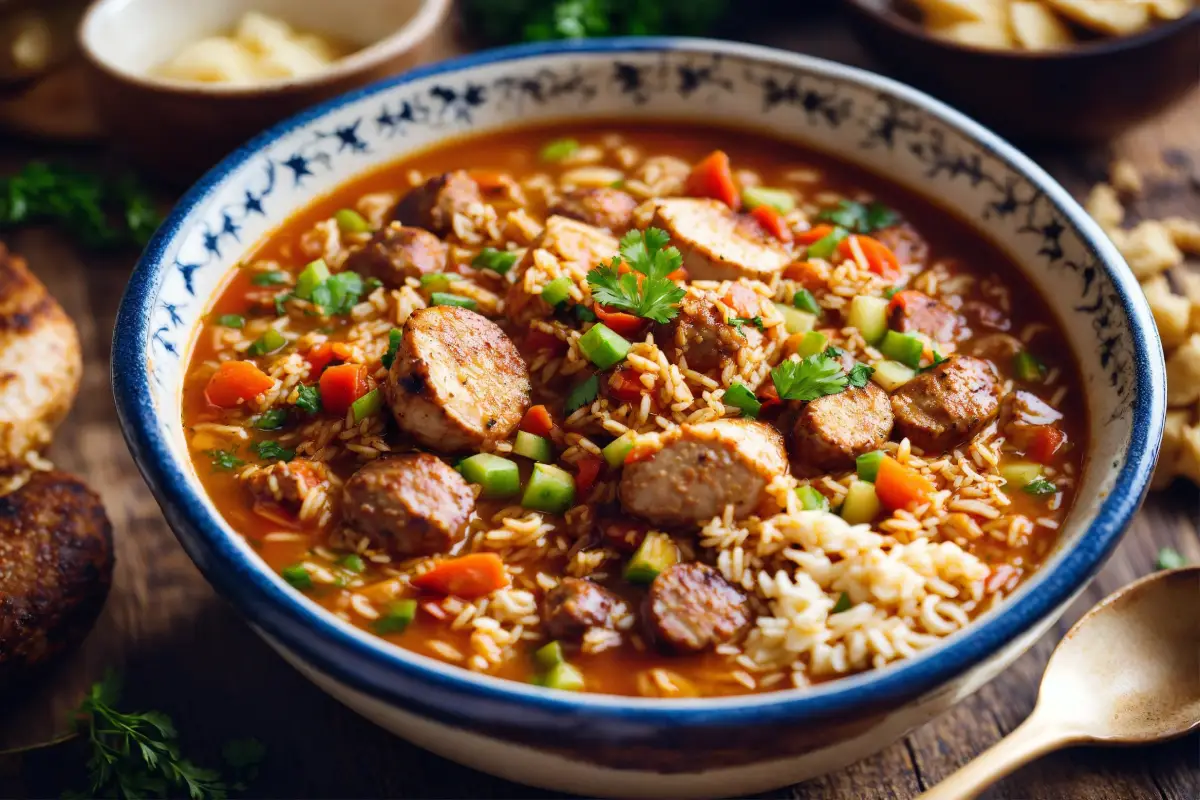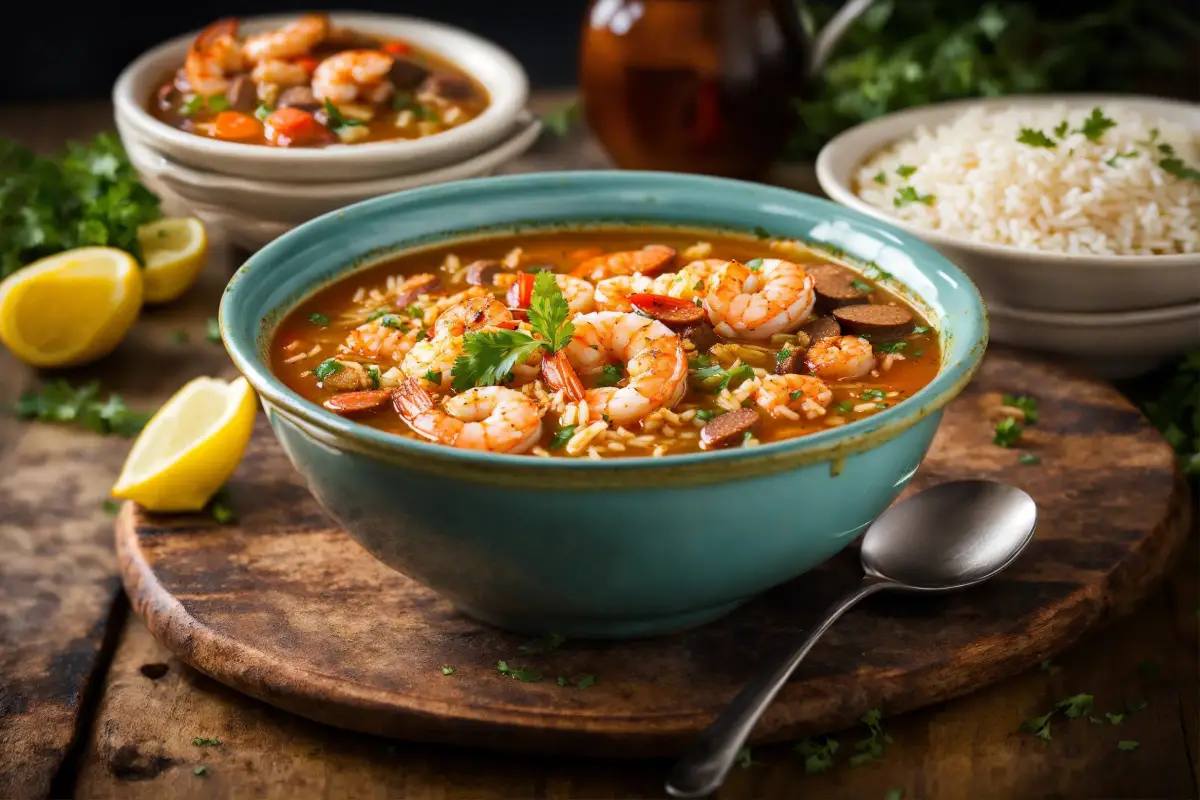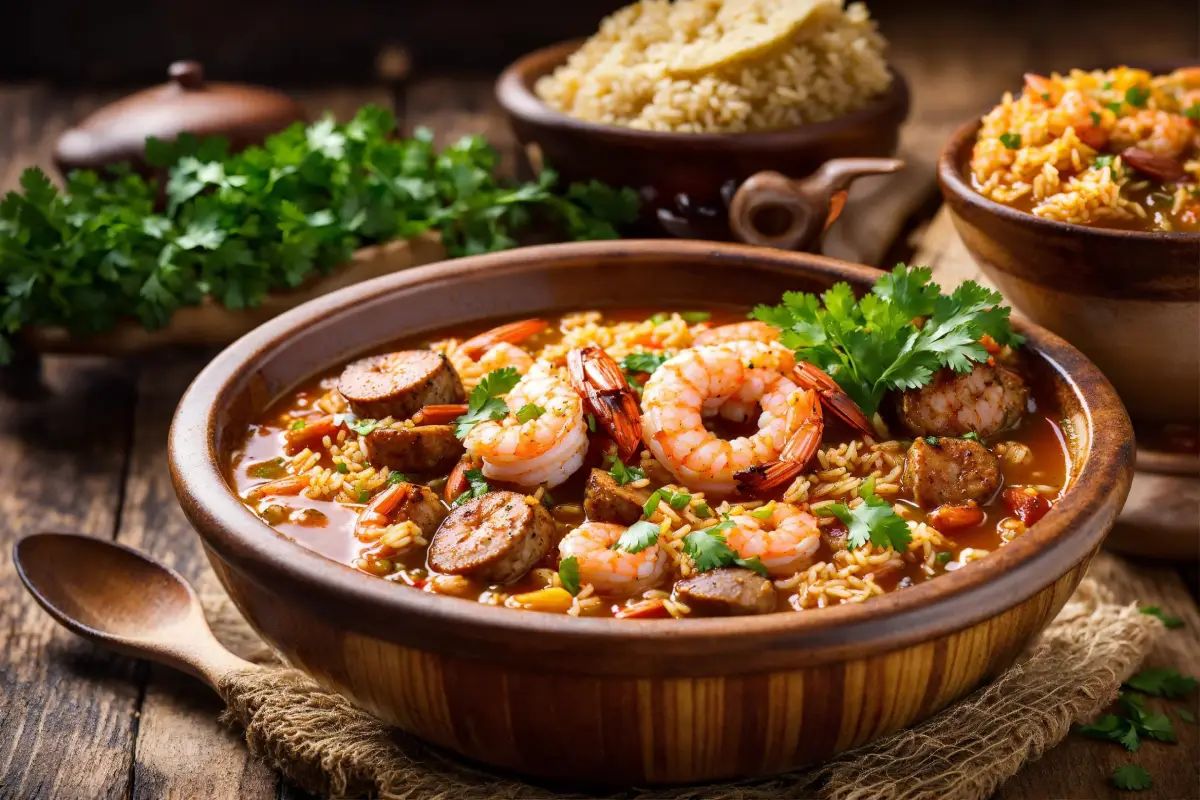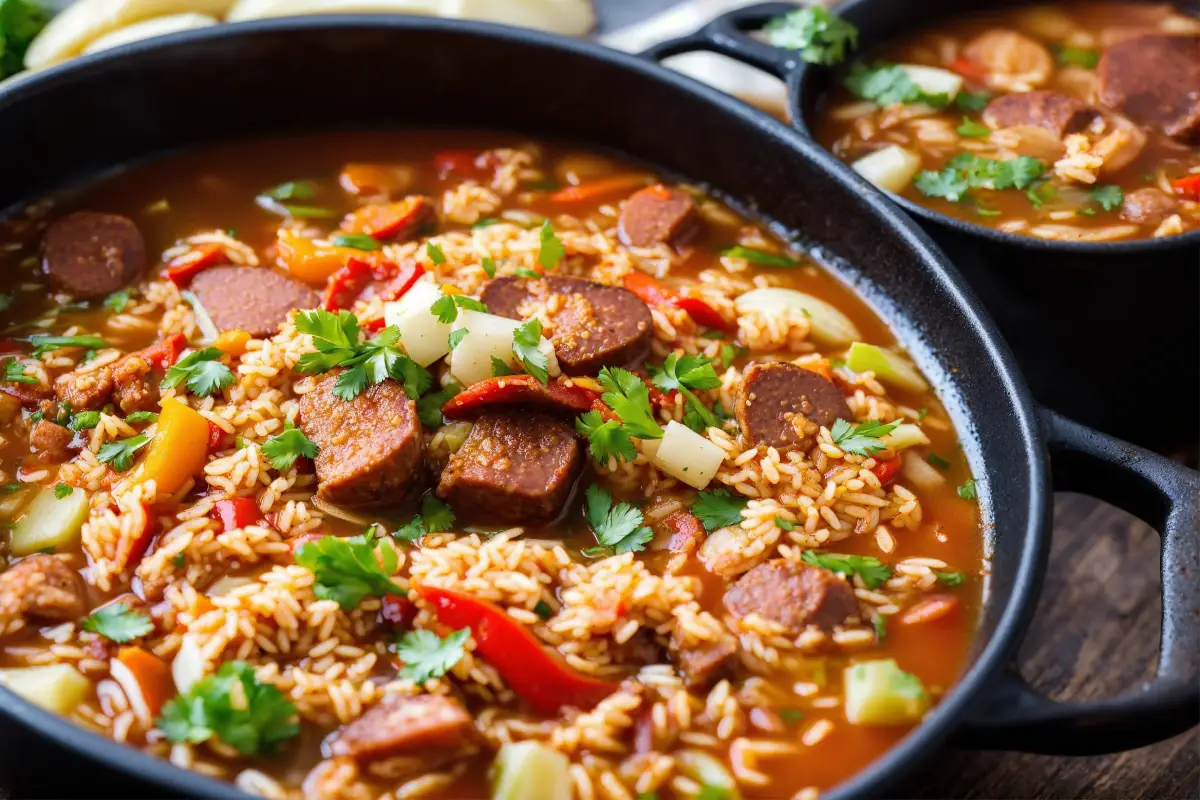Dive into the vibrant flavors of Louisiana with our Cajun Jambalaya Soup recipe, a hearty blend of andouille sausage, chicken, and shrimp, simmered in a spicy broth. This dish is a celebration of Cajun and Creole traditions, offering a taste of Southern hospitality in every spoonful. Perfect for any occasion, from family dinners to festive gatherings, our recipe brings the spirit of New Orleans to your table. Join us as we explore the rich history and diverse cultures behind this beloved dish, delving into how Cajun cuisine has evolved over the centuries.
Jambalaya soup, a cornerstone of Louisiana cuisine, has a story as diverse as its ingredients. It began as a melting pot of cultures. Spanish, French, African, and Native American influences have all left their mark on this iconic dish. Originally, jambalaya was the New World’s answer to the Old World’s paella. Over time, it evolved. Local ingredients and culinary traditions blended to create something uniquely American, particularly Louisianan.
First, the Spanish settlers aimed to recreate paella, but saffron was hard to find. Instead, they used tomatoes. Then, the French influence added spices and techniques that enriched the dish’s complexity. African cooks introduced okra, not just as a thickener but also for its flavor. Native Americans contributed with local herbs and spices, further defining jambalaya’s distinct taste.
Moreover, jambalaya reflects the history of migration and trade. The port of New Orleans, a bustling hub, facilitated the exchange of ideas and ingredients. This cross-cultural interaction is what made jambalaya a symbol of diversity and unity.
Today, jambalaya soup is a testament to adaptability and creativity. It varies from one kitchen to another, yet always remains comfortingly familiar. Whether it’s the Creole version, with its tomato-based sauce, or the Cajun variety, darker and without tomatoes, each bowl tells a story of cultural collaboration.
In essence, jambalaya soup is more than a dish. It’s a narrative of survival, adaptation, and community. It celebrates the coming together of different peoples and their traditions to create something extraordinary.
Serving and Enjoying Your Cajun Jambalaya Soup
Side Dishes:
- Cornbread: A slice of warm, buttery cornbread complements the spices of the soup beautifully, offering a sweet and savory balance.
- Green Salad: A crisp, light salad with a tangy vinaigrette can cut through the richness of the soup, refreshing the palate.
- Steamed Rice: For those who prefer a soupier jambalaya, serving it over a bed of fluffy steamed rice ensures no flavorful broth goes to waste.
- Garlic Bread: Perfect for dipping, garlic bread adds a crunchy texture and aromatic flavor that pairs well with the soup.
Drinks:
- Iced Tea: A classic Southern choice, sweet or unsweetened iced tea complements the spiciness of the dish.
- Beer: A light lager or a pale ale can balance the heat and richness of the soup without overpowering its flavors.
- White Wine: Opt for a crisp, acidic white wine like Sauvignon Blanc to refresh the palate between bites.
- Water: Always a good idea, especially with spicy foods, to keep everyone hydrated and cool.
Nutritional Information about Cajun Jambalaya Soup
Jambalaya soup can be both a hearty and nutritious meal, packed with proteins and vegetables. Here are some tips for making it lighter or more nutritious:
- Lean Proteins: Use skinless chicken breasts and turkey or chicken sausage to reduce fat content without sacrificing flavor.
- Increase Vegetables: Boost the quantity of the “Holy Trinity” or add other vegetables like spinach or kale for added fiber and nutrients.
- Whole Grain Rice: Substitute white rice with brown or wild rice for more fiber and a lower glycemic index.
- Control Sodium: Use low-sodium stock and fresh ingredients rather than canned or processed ones to keep sodium levels in check.
Seasonal Variations
Summer Freshness:
- Lighten the dish for summer by using seafood like shrimp and lighter broths. Incorporate fresh tomatoes and herbs like basil or cilantro for a bright, fresh flavor.
Winter Warmth:
- In winter, make the soup heartier by adding more sausage and chicken, and perhaps a bit of dark roux for depth. Serve with warm, crusty bread to create a comforting, warming meal.
By considering these pairings, nutritional adjustments, and seasonal variations, you can enjoy Cajun jambalaya soup year-round, adapting it to suit any occasion, preference, or dietary need. This versatility not only showcases the dish’s broad appeal but also its ability to bring people together over a shared love of good food.
FAQs about Jambalaya Soup
What is jambalaya soup made of?
Jambalaya soup is a hearty, flavorful dish made from a blend of meats, such as andouille sausage, chicken, and sometimes shrimp, cooked with the “Holy Trinity” of Cajun cuisine—onion, celery, and bell pepper. It’s seasoned with Cajun spices and simmered in a rich stock, often with rice and sometimes tomatoes, depending on the variation.
What is jambalaya made of?
Traditional jambalaya is similar to the soup version but with less liquid, making it more of a rice-based dish. It includes the same foundational elements: meats like andouille sausage and chicken, the “Holy Trinity” of vegetables, Cajun seasoning, and rice. The main difference lies in the consistency and the cooking method.
What’s the difference between gumbo and jambalaya?
While both gumbo and jambalaya are staples of Louisiana cuisine, they differ significantly in preparation and texture. Gumbo is a thick stew, often thickened with okra, roux, or file powder, and served over rice, which is cooked separately. Jambalaya, on the other hand, is a one-pot dish where the rice cooks with all the other ingredients, absorbing the flavors. Gumbo tends to be soupier, while jambalaya is more of a hearty rice dish.
Is Jambalaya supposed to be soupy?
Traditional jambalaya is not typically soupy; it’s a moist but not liquid rice dish. However, jambalaya soup is a variation that embraces a brothier consistency, combining the rich flavors of jambalaya with the comforting quality of a soup. It’s an excellent option for those who enjoy the flavors of jambalaya but prefer a dish that’s more akin to a stew.
Our journey through the flavors of Cajun jambalaya soup has been more than a culinary adventure. It’s a deep dive into Louisiana’s rich culture and traditions. This dish is not just food; it’s a celebration of community and history.
Jambalaya soup brings people together. It tells a story of cultural fusion with every spoonful. Whether for a big celebration or a simple meal, it offers a taste of Louisiana’s soul.
We’ve explored variations, nutritional tips, and pairings. This isn’t just cooking; it’s creating experiences. It’s about honoring tradition while welcoming new twists.
So, as you share this spicy, savory soup, remember it’s more than a meal. It’s an invitation to gather, enjoy, and explore the rich world of flavors. For those who cherish the healing power of soups, discover another comforting classic with our Italian Penicillin Soup, a perfect blend of wellness and flavor.
Print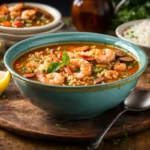
Cajun Jambalaya Soup
- Total Time: 1 hour
- Yield: 6 servings 1x
- Diet: Gluten Free
Description
Savor the essence of Louisiana with this spicy and hearty Cajun Jambalaya Soup, packed with andouille sausage, chicken, and shrimp, simmered in a flavorful broth.
Ingredients
Proteins:
- 1 lb (450g) andouille sausage, sliced
- 1 lb (450g) chicken breast, cut into bite-sized pieces
- 1/2 lb (225g) shrimp, peeled and deveined
Vegetables (The Holy Trinity):
- 1 large onion, diced
- 1 green bell pepper, diced
- 2 stalks celery, diced
- 3 cloves garlic, minced
Liquids:
- 6 cups (1.4 liters) chicken or vegetable stock
- 1 can (14 oz or 400g) diced tomatoes, with juice
Rice:
- 1 cup (240g) long-grain rice
Seasonings:
- 2 tablespoons Cajun seasoning (adjust to taste)
- 1 teaspoon smoked paprika
- 1 bay leaf
- Salt and pepper to taste
Garnishes:
- Chopped green onions, for serving
- Fresh parsley, chopped, for serving
- Lemon wedges, for serving
Optional:
- Hot sauce, for serving
Instructions
1. Prepare the Holy Trinity: Start by finely chopping one large onion, one green bell pepper, and two stalks of celery. This combination, known as the “Holy Trinity” of Cajun cuisine, forms the flavor base of your soup.
2. Brown the Protein: In a large pot, heat a tablespoon of oil over medium heat. Add diced andouille sausage and cook until slightly browned. If using chicken (boneless, skinless thighs or breasts, cut into bite-sized pieces), add it now and cook until browned. Remove the meats and set aside.
3. Sauté the Vegetables: In the same pot, add a bit more oil if needed. Sauté the chopped vegetables until they are soft and translucent, about 5 minutes. Stir in minced garlic and cook for another minute until fragrant.
4. Add Spices: Sprinkle in your Cajun seasoning to taste, along with a bay leaf. Stir well to coat the vegetables in the spices, letting the flavors bloom for a minute.
5. Combine Ingredients: Return the browned meats to the pot. If using shrimp, keep it aside for now. Add diced tomatoes (with juice for a soupier consistency) and stir. Pour in 6 cups of stock (chicken, vegetable, or seafood), ensuring everything is well combined.
6. Simmer: Bring the mixture to a boil, then reduce the heat to low. Cover and simmer for about 20-30 minutes, allowing the flavors to meld together. If you’re including rice, add it now, ensuring there’s enough liquid to cook the rice and achieve a soupy consistency.
7. Add Shrimp: If adding shrimp, stir them into the pot in the last 10 minutes of cooking. They’re done when they turn pink and opaque.
8. Final Adjustments: Taste your jambalaya soup and adjust the seasoning with salt, pepper, or more Cajun seasoning as needed. Remove the bay leaf before serving.
9. Serve: Ladle the hot soup into bowls. Garnish with sliced green onions and chopped parsley for a fresh contrast. Offer hot sauce and lemon wedges on the side for added zest and heat.
Notes
- For a thicker soup, allow it to simmer uncovered for the last 10 minutes, letting some liquid evaporate.
- Adjust the heat level by increasing or decreasing the amount of Cajun seasoning and cayenne pepper.
- For a vegetarian version, use plant-based sausages and vegetable stock. Omit the shrimp or replace it with a plant-based protein.
- Prep Time: 15 minutes
- Cook Time: 45 minutes
- Category: Soup
- Method: Simmering
- Cuisine: Cajun/Creole
Nutrition
- Serving Size: 1 bowl (approximately 1.5 cups)
- Calories: 350 kcal
- Sugar: 5g
- Sodium: 800mg
- Fat: 10g
- Saturated Fat: 3g
- Unsaturated Fat: 5g
- Trans Fat: 0g
- Carbohydrates: 45g
- Fiber: 3g
- Protein: 25g
- Cholesterol: 75mg
Keywords: Cajun Jambalaya Soup, Jambalaya Soup Recipe, Spicy Soup Recipe, Louisiana Soup, Creole Soup, Hearty Soup Recipe, Winter Soup Recipe, Mardi Gras Recipe

